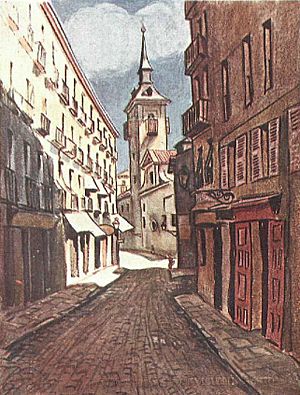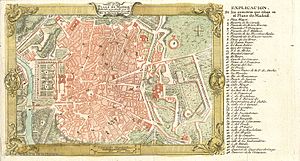Walls of Madrid facts for kids
The Walls of Madrid (Spanish: cerca de Madrid, tapia de Madrid) were a series of five different walls that surrounded the city of Madrid. These walls were built over many centuries, from the Middle Ages until the late 19th century. Some of them were for defense, like protecting the city from attacks. Others helped the city collect taxes on goods coming in.
By the end of the 1800s, Madrid was growing very fast because of the Industrial Revolution. The old walls were in the way. So, they were taken down to allow the city to expand and become the modern capital we know today.
Contents
Muslim Walls of Madrid

The Muslim Walls of Madrid are probably the oldest buildings in the city. They were built in the 9th century, when Muslims ruled the Iberian Peninsula. These walls were part of a fortress that became the start of Madrid.
The walls were ordered by Muhammad I of Córdoba, a Muslim leader, between 860 and 880 AD. They were built to protect the almudaina, which was the Muslim fortress of Mayrit (old Madrid). This fortress was located near where the Royal Palace of Madrid stands today. Historians say these walls were very strong, made of stone and mortar, and about three and a half meters thick. They also had large towers and gates.
You can still see parts of these old walls today. Some ruins are along Calle Mayor street, near the Segovia Viaduct. A long section, about 70 meters, is hidden under the Plaza de la Armería. This area is between the Royal Palace and the Almudena Cathedral.
In 1954, the Muslim walls were officially named an Artistic-Historic Monument.
Christian Walls of Madrid
The Christian Walls of Madrid, also called the Medieval Walls, were built between the 11th and 12th centuries. This was after the Reconquista, when Christian kingdoms took back control of Spain. These walls were an extension of the earlier Muslim Walls. They were needed because Madrid was growing and new neighborhoods were appearing.
It is believed that King Alfonso VII of León and Castile helped build these walls. However, some work might have started even earlier, during the time of King Alfonso VI of León and Castile.
When King Philip II made Madrid the capital in 1561, these walls were no longer needed for defense. Most of them were torn down. However, some parts of the walls are still part of older buildings in the historic center of Madrid, known as "El Madrid de los Austrias."
Like the Muslim walls, the remaining parts of the Christian walls were declared a Historical and Artistic Monument in 1954.
Walls del Arrabal

The Walls del Arrabal were the third set of walls built around Madrid. By this time, Madrid was becoming the capital of Spain. There are no parts of these walls left today, so their exact size and when they were built are a bit of a mystery. They might have been built as early as the 12th century, but it is more likely around 1438.
One reason for building these walls might have been to protect people from the terrible plagues that were happening in Spain. The walls helped to bring the growing suburbs into the city and control who came in, preventing the spread of sickness.
After the Medieval Walls, Madrid kept growing eastward. The population grew from 5,000 to 12,000 people between the mid-1400s and early 1500s. The suburbs, or arrabales, were named after churches and convents built outside the old Muslim Walls. For example, the Arrabal of Saint Martin was named after the Convent of San Martín.
These walls started near the Puerta Cerrada gate. They generally followed a path that included areas like Plaza de la Puerta del Sol and Plaza de Santo Domingo. Later, around 1520, the southern part of the wall was extended to include even more of the growing city.
Walls of Philip II
The Walls of Philip II were built by King Philip II in 1566. These walls were not mainly for defense. Instead, they were used to control trade and health. They helped the city keep track of goods and people entering Madrid. These walls enclosed an area of about 125 hectares (about 309 acres).
The walls started where the Christian Walls ended, near the current Calle Segovia. They then went through many streets, including parts of what is now Gran Vía, eventually connecting with the Walls del Arrabal near Plaza del Callao.
You can still find some small parts of these walls today, for example, near the extension of the Palacio del Senado on Calle de Bailén.
Walls of Philip IV
The Walls of Philip IV were built around Madrid between 1625 and 1868. King Philip IV ordered them to replace the older Walls of Philip II and the Walls del Arrabal. Madrid had grown so much that the old walls were too small.
These walls were not for fighting or defense. Their main purpose was to control who and what entered and left Madrid. They helped the city collect taxes on goods and keep an eye on people. The walls were built using brick, mortar, and packed earth.
The route of these walls was very long and winding, following the shape of the land. They started near Cuesta de la Vega and went around many areas, including the Buen Retiro and the Hermitage of Atocha. These walls stayed in place for over 200 years. They actually stopped the city from growing outwards, which led to very crowded conditions inside Madrid for a long time.
See also
 In Spanish: Cerca de Madrid para niños
In Spanish: Cerca de Madrid para niños




